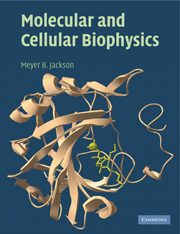Book contents
- Frontmatter
- Contents
- Preface
- Acknowledgements
- Chapter 1 Global transitions in proteins
- Chapter 2 Molecular forces in biological structures
- Chapter 3 Conformations of macromolecules
- Chapter 4 Molecular associations
- Chapter 5 Allosteric interactions
- Chapter 6 Diffusion and Brownian motion
- Chapter 7 Fundamental rate processes
- Chapter 8 Association kinetics
- Chapter 9 Multi-state kinetics
- Chapter 10 Enzyme catalysis
- Chapter 11 Ions and counterions
- Chapter 12 Fluctuations
- Chapter 13 Ion permeation and membrane potential
- Chapter 14 Ion permeation and channel structure
- Chapter 15 Cable theory
- Chapter 16 Action potentials
- Appendix 1 Expansions and series
- Appendix 2 Matrix algebra
- Appendix 3 Fourier analysis
- Appendix 4 Gaussian integrals
- Appendix 5 Hyperbolic functions
- Appendix 6 Polar and spherical coordinates
- References
- Index
Chapter 5 - Allosteric interactions
Published online by Cambridge University Press: 24 May 2010
- Frontmatter
- Contents
- Preface
- Acknowledgements
- Chapter 1 Global transitions in proteins
- Chapter 2 Molecular forces in biological structures
- Chapter 3 Conformations of macromolecules
- Chapter 4 Molecular associations
- Chapter 5 Allosteric interactions
- Chapter 6 Diffusion and Brownian motion
- Chapter 7 Fundamental rate processes
- Chapter 8 Association kinetics
- Chapter 9 Multi-state kinetics
- Chapter 10 Enzyme catalysis
- Chapter 11 Ions and counterions
- Chapter 12 Fluctuations
- Chapter 13 Ion permeation and membrane potential
- Chapter 14 Ion permeation and channel structure
- Chapter 15 Cable theory
- Chapter 16 Action potentials
- Appendix 1 Expansions and series
- Appendix 2 Matrix algebra
- Appendix 3 Fourier analysis
- Appendix 4 Gaussian integrals
- Appendix 5 Hyperbolic functions
- Appendix 6 Polar and spherical coordinates
- References
- Index
Summary
The importance of molecular associations in biological signaling processes was mentioned in the preceding chapter. That chapter concentrated on the physical aspects of the association process and paid little attention to the signaling events that are initiated by ligand binding. This chapter will accept the binding event as given, and go on to look at what consequences this has on the biological function of a protein.
Powerful theories to explain this kind of signaling can be developed by combining the concepts of molecular associations from Chapter 4 with the concepts of global states and transitions from Chapter 1. In putting these two ideas together, a key point to remember is that both processes are governed primarily by the kinds of noncovalent forces covered in Chapter 1. As a result the energies for global transitions and binding events are often in the same range. This enables an association reaction to trigger a conformational transition in a protein, and this is what makes allosteric interactions possible. Here, we will develop this theory, known as allosteric theory, and illustrate its use with examples.
The word allosteric is quite popular in molecular biology. The word was introduced as a combination of the Greek words allo and steric to mean other-site. A classical usage in this sense is when a ligand binds to a regulatory site of an enzyme and alters the enzyme's effectiveness as a catalyst.
- Type
- Chapter
- Information
- Molecular and Cellular Biophysics , pp. 111 - 141Publisher: Cambridge University PressPrint publication year: 2006
- 1
- Cited by



